The underside of trailers the components that make up the suspension system are continuing to evolve. In the last few years the industry has seen the addition of unitized hubs and more widespread specifying of air-ride suspensions for a broader range of applications. These days we are seeing continued refinements of these products plus a push toward composite systems and a return to mechanical systems for some operations all of which are giving fleets more choices. If you decide to seek a career in the heavy-duty arena, knowing the industry trends will make you a better technician, service writer or fleet manager. We have the inside scoop from some of the leaders in trailer suspension system manufacturing on what they see techs servicing/installing down the road.
In the early 90s the transition from mechanical versus air-ride suspensions began to take hold. While the up-front cost of air suspensions is still greater than the price of a mechanical suspension, according to one trailer manufacturer, the gap is closing. One reason could be that there is a growing understanding that air suspension provides better cargo and trailer component protection.
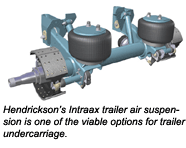 About 10 years ago, Hendrickson Trailer introduced Intraax, an integrated axle and suspension solution, which has become the backbone of its integrated axle system that has helped the company offer additional trailer suspension systems.
About 10 years ago, Hendrickson Trailer introduced Intraax, an integrated axle and suspension solution, which has become the backbone of its integrated axle system that has helped the company offer additional trailer suspension systems.
Hendrickson sees the trailer suspension market evolving to total undercarriage systems and that the wide variety of trailers on the road today dictates more specialized products, which the company says its able to provide.
The manufacturer also believes that the natural evolution of undercarriage system solutions will include wheel ends and brakes.
For the future, industry representatives predict that lighter weight solutions are going to be key, and that new designs and materials will provide excellent trailer suspension choices. Some new materials, like higher strength steel, aluminum and composites, help to provide weight savings on the rig. Others say the industry also will see more integrated systems for trailer undercarriages, solutions that address wear components such as brakes, drums and hubs.
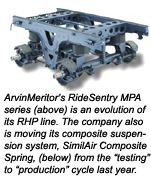 Another manufacturer, ArvinMeritor, which offers a range of air suspension systems, and has been testing a new composite suspension system SimilAir Composite Spring. The company believes there are many advantages to composite springs in trailer suspension systems, and that this trend will become more popular.
Another manufacturer, ArvinMeritor, which offers a range of air suspension systems, and has been testing a new composite suspension system SimilAir Composite Spring. The company believes there are many advantages to composite springs in trailer suspension systems, and that this trend will become more popular.
The reason? Better riding composite springs could target trailer users interested in improving ride quality without maintenance concerns and cost penalty of air suspensions. The manufacturer said its SimilAir product gives a ride that approaches that of an air ride systems, but as a total system it is less expensive to purchase than air. They also dont have the maintenance concerns represented by the air bags, shock absorbers, bushings and leveling valves require by air suspension.
 Industry insiders say that fleets that are looking for a better ride, but dont want to purchase an air-ride suspension system, would find this a viable and affordable option. Despite the growth in air suspensions, many large fleets continue to use mechanical trailer suspensions. And, some fleets that had been specifying air suspension systems are considering going back to mechanical systems. These are the fleets that might find that a composite system gives them the best of both worlds.
Industry insiders say that fleets that are looking for a better ride, but dont want to purchase an air-ride suspension system, would find this a viable and affordable option. Despite the growth in air suspensions, many large fleets continue to use mechanical trailer suspensions. And, some fleets that had been specifying air suspension systems are considering going back to mechanical systems. These are the fleets that might find that a composite system gives them the best of both worlds.
When asked about current specing trends for trailer suspensions, one product manager for the commercial vehicle systems group of Dana Corp., replied that during the past decade, they have seen air-ride suspensions taking on an increasingly larger share of the market when compared to mechanical spring ride systems. Dana said it attributes that to the ride benefits, lightweight designs and resale value of air suspensions, which is why the company continues to focus on these areas with the design and development of all new systems.
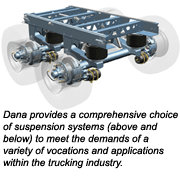 Dana engineers said that due to the high demand for trailers of all types and sizes that industry is experiencing right now, the mechanical spring market is also going through a growth spurt. And, there will always be applications where mechanical suspensions are better suited for a specific application especially off-road situations.
Dana engineers said that due to the high demand for trailers of all types and sizes that industry is experiencing right now, the mechanical spring market is also going through a growth spurt. And, there will always be applications where mechanical suspensions are better suited for a specific application especially off-road situations.
Despite this, Dana sees both markets growing, with the demand for air rides perhaps stabilizing somewhat in 2006, but in no way shrinking.
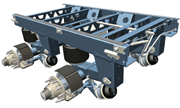 With the multitude of vocations, applications and duty cycles that todays heavy trucks are being asked to tackle, some suspension system developers are reluctant to say one suspension system is more appropriate than another. It really comes down to selecting a supplier that delivers the total package, regardless of suspension type. While lightweight, low maintenance and smooth ride are the buzz words most often heard today, fleet managers also will want to put a system under their trailer that will give them years and years of excellent service.
With the multitude of vocations, applications and duty cycles that todays heavy trucks are being asked to tackle, some suspension system developers are reluctant to say one suspension system is more appropriate than another. It really comes down to selecting a supplier that delivers the total package, regardless of suspension type. While lightweight, low maintenance and smooth ride are the buzz words most often heard today, fleet managers also will want to put a system under their trailer that will give them years and years of excellent service.
The Holland Group offers a portfolio of both air-ride and mechanical suspensions as a result of evolving products and technologies from the former Neway, Binkley and Holland Hitch organizations.
Hollands newest air ride system for the North American Van Market, the CB4000, has a slider box used in the system. The SwingAlign unit, a new, patent-pending axle alignment feature that utilizes that same acme screw technology that is found in Hollands landing gears, is the industrys first axle alignment feature that does not require any disassembly, special tools or replacement parts. The CB4000s pivot bushing is another new patent pending design which introduced new stress reducing geometries that greatly increased the component life. The trailer team also teamed up with the casting experts from Hollands fifth-wheel group to develop a new integral cast trailing-arm beam in lieu of a traditional fabrication that requires more than 20 individual parts.
From a mechanical perspective, Holland offers the UltraLite2 suspension/slider package for those customers that prefer a mechanical solution to air ride. Hollands QwikRelease pin pull mechanism, which was originally used on Binkley mechanicals, is now standard on all air and mechanical suspension/slider products.
Standardization of components between air and mechanical systems optimizes operations and reduces cost along the whole distribution chain.
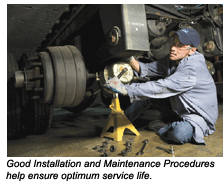 Fleets that want the most for their suspension dollar need to consider up-front cost without losing site of costs related to performance and maintenance. If you enter this career path, educate yourself with a supplier about the many product options they offer and give them details on your trailer applications. With all the new products, and systems along with practical ways to specify mechanical systems for specific applications there are greater opportunities for finding the best suspension system for the fleet you service one day.
Fleets that want the most for their suspension dollar need to consider up-front cost without losing site of costs related to performance and maintenance. If you enter this career path, educate yourself with a supplier about the many product options they offer and give them details on your trailer applications. With all the new products, and systems along with practical ways to specify mechanical systems for specific applications there are greater opportunities for finding the best suspension system for the fleet you service one day.
| Scholarship Update Students preparing for a career in the automotive industry, as well as qualified graduates paying off existing student loans, are invited to apply for financial assistance through the Specialty Equipment Market Association (SEMA) Memorial Scholarship Fund (SMSF). Since 1984, the SMSF has awarded more than 700 students and graduates with a total of $800,000 in scholarship awards. Through the program, scholarships ranging from $1,000 to $4,000 are awarded to students enrolled in a full-time program with an accredited university, college or proprietary program in the U.S. or Canada. The SMSF also includes a Loan-Forgiveness Program that provides financial assistance to graduates who have worked with a SEMA-member company for at least one year and who have an outstanding student loan. Applications are available at www.sema.org/scholarship and are due by April 27. For more information, contact SEMA at 909-396-0289 or [email protected]. The Car Care Council Women’s Board awards scholarships to female students who are pursuing education to prepare them for a career in the automotive aftermarket. The High School Scholarship is open to female high school seniors who plan on attending an ASE-certified, post-secondary automobile technology program. (One $1,000 scholarship awarded.) The Technician Scholarship is open to female students who have completed one year at an ASE-certified, post-secondary automotive technology program. (One $2,500 scholarship plus trip to AAPEX show in Las Vegas and one $1,500 scholarship will be awarded.) Applicants must satisfy and submit the following: Current grade point average (2.5 or better) and graduation date; Official transcript with embossed school seal and instructors letter of recommendation; Completed scholarship application A brief narrative about on goals and the importance of the scholarship; A brief description of community service and extracurricular activities. Submission deadline is May 15. Winners will be announced in July. For more information, contact Emily Baxter at 301-654-6664 or [email protected]. Applications are available for download at www.carcare.org/Womens_Board/ womens_board.shtml |











